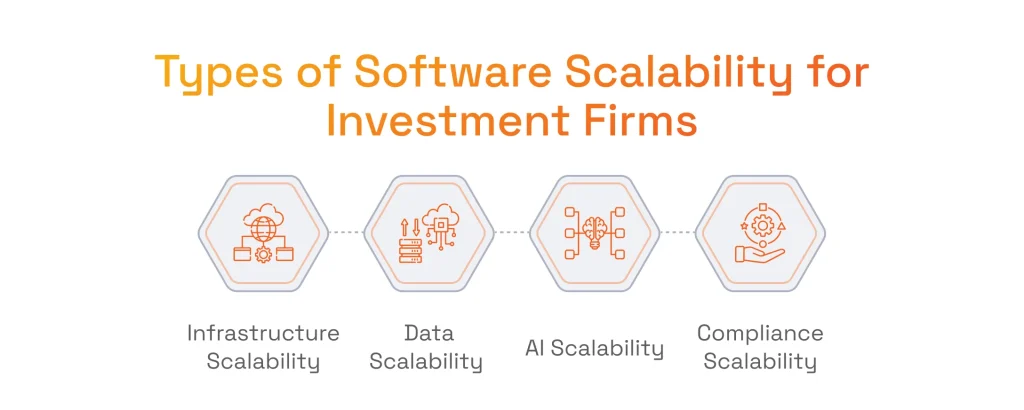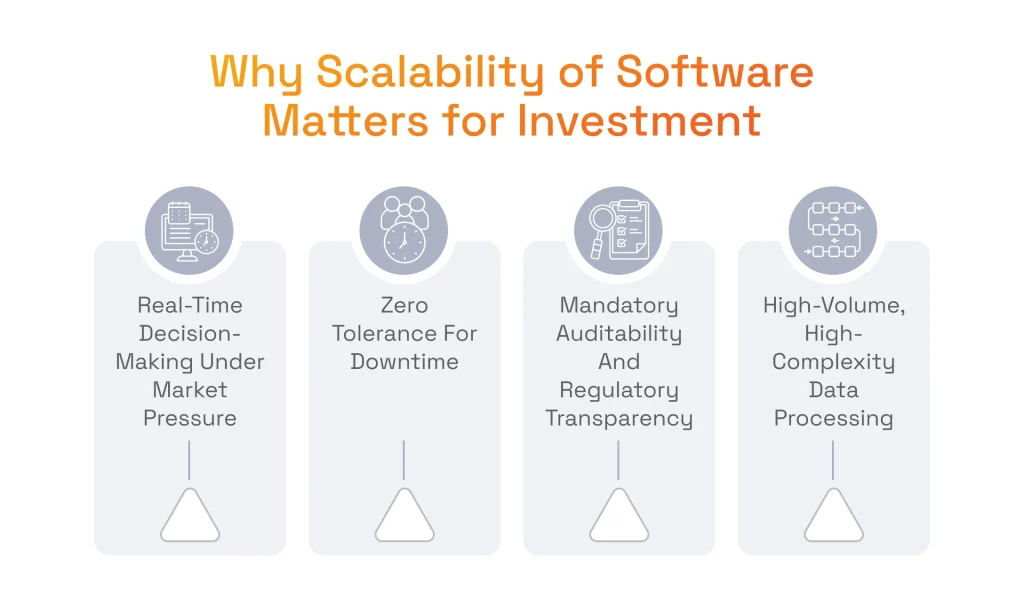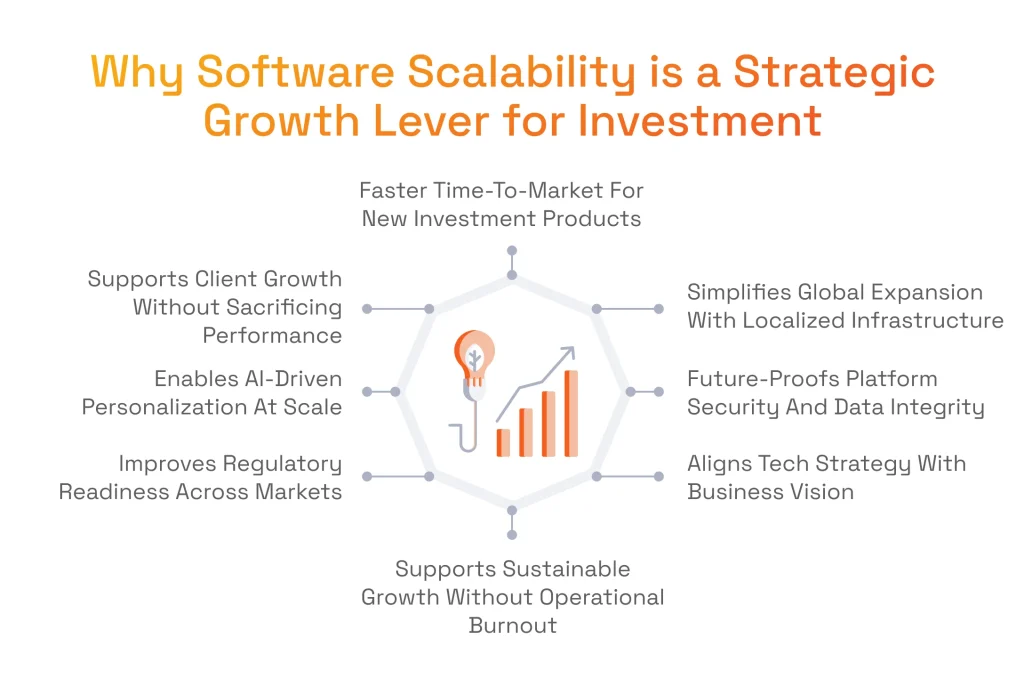Investment firms are flooded with data like never before in the modern market, which combines a vast amount of entirely different data sources. The Wall Street Journal reports that Bloomberg’s BQuant analytics tools alone process over 400 billion daily market ticks on a daily basis, reflecting the immense scale of live market data that investment firms must handle.
Real-time price feeds, ESG metrics, investor behavior analytics, and ever-evolving regulatory reporting obligations are not just growing; they’re exploding at an unprecedented pace. Today, software scalability is not just an option but an essential element of a modern investment solution.
In this article, we will discuss the scalable software meaning for investors, ways to mitigate risks, and how to assess the readiness of your current infrastructure for potential growth.
Investment Software Scalability: What It Really Means Today
It is hard to overestimate the importance of modern scalable investment software in matching the needs of organizations and gaining a competitive advantage. Let’s discuss why is scalability important in this industry and its specifics.
What Is Scalability in Software
In the product development process, scalability in software refers to the system’s ability to handle increased load without sacrificing reliability and performance. The load may include more active users, transactions, and data. A truly scalable system can grow exponentially according to demand, adapt to spikes in usage, and increase the number of operations without needing a complete overhaul of the architecture.
While that definition applies broadly across many industries, software scalability is uniquely critical in the investment sector. Financial institutions have many more requirements for software scaling and supporting more users. The challenge is managing the increasing complexity of data, compliance, and analytics while still ensuring data security in fintech applications.
So, the scalability of software in investment includes:
- Supporting an increasing number of user accounts and clients.
- Handling expanding volumes of data, from unstructured ESG reports to structured price feeds.
- Scaling AI models for more precise and faster decision-making.
- Maintaining compliance and transparency across all jurisdictions as regulations evolve.
Types of Software Scalability Investment Firms Must Address
Investment firms have a unique challenge of addressing multiple forms of scalability simultaneously. Let’s discuss them in more detail.

1. Infrastructure Scalability
The role of scalability in modern software architecture is determined by how well the backend, including servers, databases, and cloud environments, can grow with demand. As the investment firm grows and trading activity expands, cloud-native infrastructure opens up elastic compute power, geographic distribution, and load balancing to maintain peak performance during rapid growth.
2. Data Scalability
It is common for investment platforms to operate with varied and extensive data inputs. This includes historical price data, market indexes, real-time trade feeds, and alternative data like social sentiment or ESG metrics. A scalable data layer efficiently ingests, stores, and analyzes both structured and unstructured data, enabling on-demand analytics, back testing, and reporting.
3. AI/ML Scalability
Using AI in investment banking is becoming increasingly popular. Artificial intelligence is increasingly embedded into investment workflows, from portfolio optimization and fraud detection to client personalization. If Business Insider is to be believed, JPMorgan Chase alone has integrated AI across its operations as part of a record $18 billion technology investment in 2025.
Scalability is the core of any AI solution, as ML models are trained on massive datasets, continuously refined, and deployed in real time at the required scale. Without scalability, AI/ML projects are getting stuck at the proof-of-concept stage.
Among our numerous AI projects, we have a successful example of scaling Morningstar’s financial platform with AI and сloud. Our experts developed a custom Web Crawler application to completely automate the core business lines. They implemented a mechanism that allowed data analysis tasks to be performed by two people instead of 20.
4. Compliance Scalability
Regulations and compliance requirements are constantly evolving, so investment software should be able to handle cross-jurisdictional reporting, granular audit logs, and automated risk assessments. Scalable compliance systems should be able to adapt to changing requirements without manual rework, ensuring firms remain audit-ready and avoid costly penalties.
Why Scalability of Software Matters More in Investment Than Most Other Industries
For many industries, software scalability is essential for organization’s success. In the investment industry, however, scalability is critical, as this sector stands out with a unique mix of complexity, speed, and regulation. Even the slightest technical limitations can result in costly reputational damages and lost opportunities.
Here are some of the distinctive factors in investment that make scalable technology so valuable:

- Real-time decision-making under market pressure: Traders and portfolio managers rely on instant access to live market data, risk analytics, and rebalancing tools. Even a few-second delay during volatile market conditions can result in missed trades or costly exposure. Scalable systems ensure responsiveness doesn’t degrade as users, data sources, or trading volume increase.
- Downtime is not an option: Periods of market stress often trigger the highest usage peaks, meaning software must scale instantly and flawlessly. A single outage can cause direct revenue loss, regulatory penalties, and long-term damage to client trust, especially for institutional investors who expect enterprise-grade reliability.
- Auditability and regulatory transparency: Investment companies are subject to evolving compliance requirements, as platforms must capture the details of every trade, decision, and data input. As businesses expand across jurisdictions, scalability ensures compliance workflows and audit trails remain intact and up to speed.
- Data complexity and volume: Scalable data pipelines and infrastructure are critical for normalizing, analyzing, and acting on information in real time, since investment platforms nowadays process everything from unstructured ESG disclosures to millisecond-level market feeds.
Scalability as a Strategic Growth Lever — Not Just a Tech Concern
According to Statista, revenue in the investment banking market is projected to reach USD 134.42 billion in 2025 in the United States alone. As growth becomes inevitable for all successful investment firms, business leaders can no longer view scalability in software engineering as a purely technical solution to current infrastructure and system performance issues. On the contrary, scalability should be designed intentionally within investment software, as it can become a powerful strategic lever to boost revenue growth, product velocity, and regulatory adaptability.
Let’s look closer at why scalability should be there by design when your chosen vendor delivers software development services for your investment company.

Faster Time-to-Market for New Investment Products
The competition in the investment market is stronger than ever, so the ability to launch new financial products can be game-changing. Whether it’s thematic ETFs, custom SMAs, or AI-enhanced advisory tools, software scalability allows for the streamlined product development process and even parallel workstreams thanks to modular architectures. Thanks to the cloud-native deployment and automated CI/CD pipelines, companies can build and launch products fast, quickly turning an idea into a revenue booster.
Supports Exponential Client Growth Without Sacrificing Performance
With an investment firm’s growth, several principal expansion demands arise, including onboarding thousands of new investors and expanding institutional partnerships. Scaling software in this scenario means being ready for increased account complexity, concurrent users, and rising data volume without requiring system re-engineering. Regardless of company size or market load, it is critical for an investment firm that the customer experience remains intuitive, fast, and reliable.
Enables AI-Driven Personalization at Scale
With the advancements of data analytics in finance and investment, the baseline customer expectation for personalization is exceptionally high. Artificial Intelligence is at the forefront of personalization by providing functionality like portfolio recommendation, discovering new investment opportunities, and insights based on individual behavior. However, scalability is critical for AI solutions to operate across thousands or millions of users in real time. It allows companies to run inference engines at scale, continuously feed them with fresh data, and integrate insights into customer-facing applications without any latency or drift.
Find details on how AI-driven platforms transform investment decisions in our featured article!
Improves Regulatory Readiness Across Markets
Whether implementing KYC standards in financial services or adhering to an ever-evolving variety of regulations, scalability solutions are required for timely adaptation. Records, reporting, and audit trails across entirely different jurisdictions need to be automated. This is especially important for companies entering new regions and asset classes, where compliance requirements may vary dramatically.
Simplifies Global Expansion with Localized Infrastructure
Platforms built on multi-region cloud infrastructure with horizontal scalability allow companies to enter new markets without using separate tech stacks and re-developing. Companies can localize interfaces, adjust to regional laws, and minimize latency for international users without duplicating engineering efforts. This scalability helps investment firms to proceed with global expansion and improve brand consistency across borders.
Future-Proofs Platform Security and Data Integrity
Horizontal and vertical scalability are impossible without robust and forward-thinking security measures, as cyberthreats are evolving rapidly. Modern scalable systems have a zero-trust architecture, support real-time anomaly detection, and offer encrypted data pipelines by default.
Aligns Tech Strategy with Business Vision
Having the necessary scalability allows business leaders to align the long-term evolution of an investment platform with the business goals. Whether the bigger picture lies in entering new markets, introducing an asset management data analytics solution, or expanding product offerings, well-crafted software provides an operational foundation to support that ambition.
Supports Sustainable Growth Without Operational Burnout
Lastly, software scalability meaning goes beyond simply adding capacity, but also doing so efficiently and sustainably. Unscalable systems require staff increases, infrastructure, and management overhead to support growth. On the contrary, scalable platforms leverage automation, orchestration, and resource optimization to grow linearly, which helps to reduce operational strain and grow healthy.
Dmytro Tymofiiev
Delivery Manager at SPD Technology
“Investment companies that embed scalability in the DNA of their software receive much more than technical flexibility. They gain the capabilities to improve client service, grow smarter, and adapt faster to emerging market changes. The primary purpose is to design systems for continuous value, as the scalability has already become a strategic foundation for lasting success.”
Software Scalability Self-Check: Questions for Tech and Business Leaders
As we have already established, software scalability can no longer be considered a future consideration but rather a strategic imperative. Unfortunately, many companies still realize they have scalability problems when their systems already lack performance, have a poor client experience, or fail to meet compliance requirements.
Reactive firefighting is costly and ineffective, so business leaders must ask themselves some tough questions. These questions, however, are not about pinpointing failure, but rather uncovering bottlenecks and growth-limiting friction points before they cause massive damage.
Yes, it makes sense to contact a professional software vendor to fully leverage the advantages of strategic technology consulting and learn how to benefit from different software scalability types. However, the following questions serve as a litmus test to assess whether your investment platform can match your ambitions.
Ready to find the perfect vendor to build a winning investment platform? We’ve prepared a list of the best fintech development companies with the necessary expertise and experience!
Can your system handle 5x data growth without re-architecture?
The volume of data is constantly growing faster than your roadmap. Whether it is client-specific analytics, alternative data sources, or real-time market feeds, straining your infrastructure can become a costly problem. Lacking the capability to scale linearly and efficiently to accommodate the data volume can result in missed opportunities during potential re-architecture of the entire system.
Are AI/ML features causing performance drag as usage increases?
Having some AI/ML solution integrated is so common nowadays that it can be considered mandatory for investment platforms. The bad news is that poorly integrated AI/ML models will become a bottleneck rather than a breakthrough. If inference latency increases along with the usage growth or ML models retraining cycles cause downtime, that is a significant marker that your software architecture lacks AI scalability. The result of this? Your platform most certainly underdelivers, or even worse, degrades client experience.
Can your compliance reports be updated dynamically across jurisdictions?
Regulations are constantly changing across the SEC, ESMA, and SFDR, as well as on the local level. Under this pressure, static compliance systems are failing. You risk falling behind or becoming out of compliance if your platform can’t dynamically adapt report formats, thresholds, or timelines by region. As a scalability example here, modern platforms can support regulatory agility without manual workarounds.
Does your analytics pipeline still meet decision-maker speed expectations?
In investment management, actionable insight loses value by the second. If your analytics dashboards lag, refresh rates are delayed, or decision-makers still rely on CSV exports and manual models, your system may no longer match business needs. As strategies evolve and portfolios diversify, analytics should be lightning fast and reliable.
Time to Reassess?
If you don’t have clear answers to any of these questions, it may be time to reassess your scalability roadmap strategically. The cost of delayed action may be much more than just a technical debt, but instead missed opportunities and lost clients.
Dmytro Tymofiiev
Delivery Manager at SPD Technology
“If some of the questions above raise concerns, you are not alone. Many investment firms hit invisible ceilings. The reason for this is not a lack of vision but the fact that the systems are simply not designed to grow along with increasing data complexity, client expectations, and regulatory dynamics. There is a way to change this with the right assessment and modern architecture development services from a professional vendor with a proven track record of completed projects.”
Conclusion: Long-Term Growth Starts with Scalable Foundations
The truth is, investment firms are now feeling the constant pressure to process massive amounts of information, while doing it smarter and faster than ever. What is scalability in software for investment firms? The scalability of software allows achieving this goal and more, helping to not only keep up with competitors but also stay ahead. Having agility and scalability in software architecture makes it possible to unlock operational efficiency, remain compliant, and seize new opportunities as markets evolve.
SPD Technology specializes in developing future-ready solutions for investment firms, successfully overcoming the most sophisticated fintech application development challenges. We bring profound expertise in AI/ML, data analytics, and scalable architecture designs to improve the operations of institutional investors, asset managers, and fintech innovators. Whether modernizing an enterprise-grade legacy platform or launching a groundbreaking startup, our teams will find an individual approach to help you scale confidently!
FAQ
How Do I Know If My Software Is Scalable?
The scalability of software is determined by its ability to perform under increased workloads. Key indicators include:
- Maintaining reliability and speed during peak usage.
- Scaling up and down based on demand without any disruptions.
- Supporting modular architecture with microservices or APIs, allowing for incremental upgrades.
- Possibility of integrations with new data sources like ESG feeds or behavioral analytics without any significant redesign of the system.
What Tools Help with Scalability Testing?
Several effective off-the-shelf tools help assess software application scalability. While every case is unique and there is no one-size-fits-all option, it makes sense to consider Apache JMeter, Locust, Gatling, New Relic / Datadog, AWS CloudWatch, and Azure Monitor.
Is Cloud Computing Beneficial for Scalability?
Cloud computing plays a pivotal role in software architecture scalability for investment firms in several ways:
- Dynamic scalability of computing power and storage based on demand.
- Global reach thanks to running servers closer to users with minimal latency.
- Reasonable pricing according to the pay-as-you-go model.
- A variety of built-in tools in cloud solutions, from testing to monitoring features.
- Adherence of cloud solutions to stringent security and financial industry standards.


